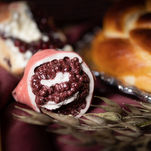Building a plaster mold
- Kate Clarke

- Jan 7, 2023
- 3 min read
Here's a #deepdive into my process!! There are two major steps to my process. First is to make a plaster mold from a real object, which can be used many, many times. The second step is to create the clay objects from these molds. Here's a basic video of how I make the molds!
I choose the most perfect, and largest of whatever I want to mold. Largest, because the clay shrinks about 20% in the kiln, so I need to start off big if I want it to end up normal size. Some food objects have textures or moisture that will prevent the plaster from setting up properly, so I sometimes spend a lot of time figuring out how to get around that: carefully blotting off lemon juice from the cut section, creating a little clay bed for the oysters to be pinned down to, a water barrier over the avocado flesh because it does something weird to the plaster... Every object is a different challenge!
Then I have to divide up the shape of the 3D object so that the sections of the mold can pull straight away from the cast, releasing it without hooking onto an undercut. I build up clay around the object, up to the line that I established as a mold divide, to block off the future sections from the first plaster pour. This step is a fun brain activity for me, like deconstructing a three dimensional puzzle.
Then I clamp wooden "cottles" around the clay/object assembly, to create a container for me to pour plaster into. Such an under-appreciated step: I used to halfass this part and more than a few times I ended up with quarts and quarts of liquid plaster busting the dam and splattering allllll over the place. What a mess!
Next, I take off the cottles, flip the beast upside down, so that I can peel the clay away from the newly set plaster of the first mold piece. I shave down the plaster to the cleanest shape, add round "keys" so that the mold pieces all fit together exactly and firmly, and then paint Murphy's Oil Soap all over the exposed plaster. This works as a really great mold release, because plaster poured onto old plaster will just permanently bond together, and the oil left by the soap prevents this.
Now it's time to start on the second mold piece! If it's only a two part mold, which would be for simple shapes with no undercuts like bananas or peppers, then all I have to do now is put the cottles back on, and pour more plaster.
But if it's a complicated shape, it will take three, four, even five mold pieces! So again I build up clay to the next mold divide line, replace cottles, pour plaster, shape up the newly set plaster and then coat with mold release, and repeat until my original object is completely encased in plaster!
To finish the mold, I leave it totally alone so the plaster can cure for at least a day. Then I use a wedge to carefully pop the plaster pieces away from each other, and the object inside. It's gotta be done carefully so that I don't loose chunks of plaster off the mold - these missing pieces will turn into chunks of extra clay that I need to remove from every cast. The more perfect the mold, the less I need to do to every single cast the comes out of that mold, for at least 100 casts, so I put in very meticulous attention to my molds.

























Comments